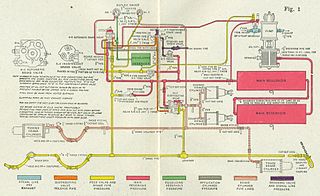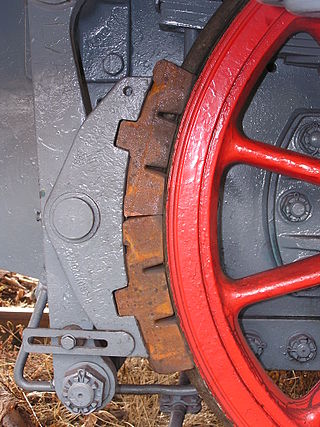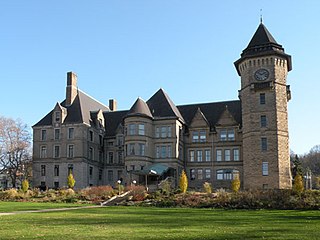
A railway air brake is a railway brake power braking system with compressed air as the operating medium. Modern trains rely upon a fail-safe air brake system that is based upon a design patented by George Westinghouse on April 13, 1869. The Westinghouse Air Brake Company was subsequently organized to manufacture and sell Westinghouse's invention. In various forms, it has been nearly universally adopted.
Westinghouse may refer to:

Chippenham is a market town in northwest Wiltshire, England. It lies 13 miles (21 km) northeast of Bath, 86 miles (138 km) west of London, and is near the Cotswolds Area of Natural Beauty. The town was established on a crossing of the River Avon and some form of settlement is believed to have existed there since before Roman times. It was a royal vill, and probably a royal hunting lodge, under Alfred the Great. The town continued to grow when the Great Western Railway arrived in 1841. The town had a population of 36,548 in 2021.
Invensys Ltd. was a multinational engineering and information technology company headquartered in London, United Kingdom. It was formed in 1999 through the merger of BTR plc and Siebe plc. It had offices in more than 50 countries and its products were sold in around 180 countries. The company was founded on 1 April 1920 as Siebe Gorman & Company Ltd and continued through various name changes registered at Companies House from that date. In January 2014 the company was taken over by the French multinational Schneider Electric for a total consideration of $5.5 billion. Schneider phased out the "Invensys" name in favour of its own.

In railway signalling, an interlocking is an arrangement of signal apparatus that prevents conflicting movements through an arrangement of tracks such as junctions or crossings. The signalling appliances and tracks are sometimes collectively referred to as an interlocking plant. An interlocking is designed so that it is impossible to display a signal to proceed unless the route to be used is proven safe.

A railway brake is a type of brake used on the cars of railway trains to enable deceleration, control acceleration (downhill) or to keep them immobile when parked. While the basic principle is similar to that on road vehicle usage, operational features are more complex because of the need to control multiple linked carriages and to be effective on vehicles left without a prime mover. Clasp brakes are one type of brakes historically used on trains.

The Westinghouse Air Brake Company was founded on September 28, 1869 by George Westinghouse in Pittsburgh, Pennsylvania. Earlier in the year he had invented the railway air brake in New York state.
Invensys Rail Group was a division of Invensys, a UK-based multinational engineering company. It was a designer, manufacturer and integrator of railway equipment, including automation, signalling and controls. The group was headquartered in Chippenham, Wiltshire, and as of 2005, had over 2,750 employees in 14 locations internationally. It operated through four companies:
Westinghouse Rail Systems Ltd was a British supplier of railway signalling and control equipment to the rail industry worldwide. Its head office was in Chippenham, Wiltshire, where it manufactured a variety of mechanical and electrical/electronic railway signalling equipment. It had six other UK offices in Croydon, York, Birmingham, Crawley, Swanley and Glasgow. It also had a number of overseas offices, particularly in the Far East, including Melbourne.

Chippenham railway station is on the Great Western Main Line (GWML) in South West England, serving the town of Chippenham, Wiltshire. It is 93 miles 76 chains down the line from the zero point at London Paddington and is situated between Swindon and Bath Spa on the GWML. The Wessex Main Line diverges from the GWML to the southwest of Chippenham and runs to Trowbridge via Melksham.

A magnetic track brake is a brake for rail vehicles. It consists of brake magnets, pole shoes, a suspension, a power transmission and, in the case of mainline railroads, a track rod. When current flows through the magnet coil, the magnet is attracted to the rail, which presses the pole shoes against the rail, thereby decelerating the vehicle.
The New York Air Brake Corporation, located in Watertown, New York, is a manufacturer of air brake and train control systems for the railroad industry worldwide.
Wheel slide protection and wheel slip protection are railway terms used to describe automatic systems used to detect and prevent wheel-slide during braking or wheel-slip during acceleration. This is analogous to ABS and traction control systems used on motor vehicles. It is particularly important in slippery rail conditions.

Knorr-Bremse AG is a German manufacturer of braking systems for rail and commercial vehicles that has operated in the field for over 110 years. Other products in Group's portfolio include intelligent door systems, control components, air conditioning systems for rail vehicles, torsional vibration dampers, and transmission control systems for commercial vehicles. In 2019, the Group's workforce of over 28,000 achieved worldwide sales of EUR 6.93 billion.

Bowerhill is a village near Melksham, Wiltshire, England, in the civil parish of Melksham Without. Central Bowerhill is approximately 1.75 miles (2.8 km) south of Melksham town centre.

Theodor Georg Knorr was an engineer and entrepreneur on the field of railroad technology and founder of the company Knorr-Bremse. He is particularly remembered for his role in the development of the compressed air brake.

The Kunze-Knorr brake is an automatic compressed-air brake for goods, passenger and express trains. It was the first graduated brake for goods trains in Europe. When it was introduced after the First World War, goods train brakes switched from hand operation to compressed-air in various European countries. The Deutsche Reichsbahn alone put the cost of equipping German goods wagons with Kunze-Knorr brakes between 1918 and 1927 at 478.4 million Reichsmarks. The operating cost savings from faster goods services and having fewer brakemen was assessed by the Reichsbahn at almost 96.3 million Reichsmark annually.
Kiepe Electric GmbH is a German manufacturer of electrical traction equipment for trams, trolleybuses other road and rail transport vehicles, as well as air-conditioning and heating systems, and conveyor device components. Founded in 1906, it was known as Kiepe Elektrik GmbH until 2003, when it was renamed Vossloh Kiepe, following its acquisition by Vossloh AG. Vossloh sold the company to Knorr-Bremse in January 2017, and in May 2017 Knorr renamed it Kiepe Electric GmbH.

John Saxby was an English engineer from Brighton, noted for his work in railway signalling and the invention of the interlocking system of points and signals. He was later a partner in the firm Saxby and Farmer. He is regarded as "the father of modern signalling".
IXYS Corporation is an American company based in Milpitas, California. IXYS focuses on power semiconductors, radio-frequency (RF) power semiconductors, and digital and analog integrated circuits (ICs).













